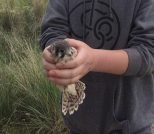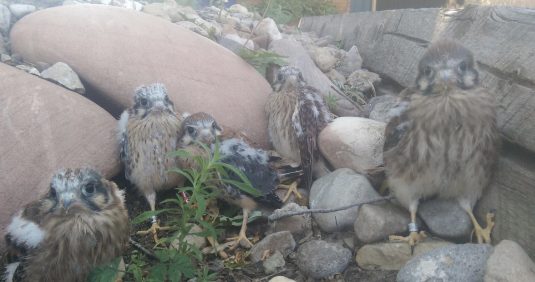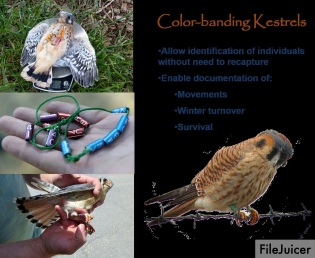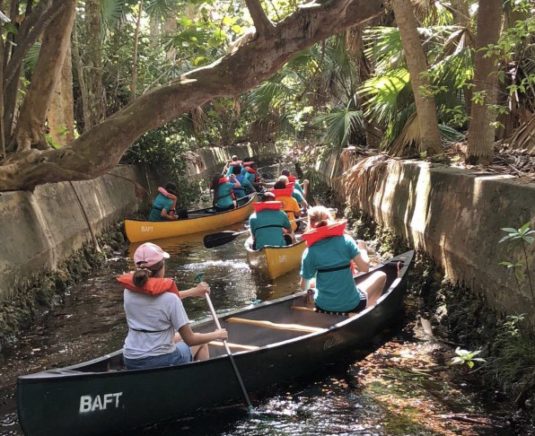environmental education
HawkWatch International: Using Hands-on, Real-life Learning to Improve Student Achievement

What were the goals of the project?
The goals of the “Cavity Nester Citizen Science Study” fall into four categories:
- To improve science proficiency in local high school students by giving students the opportunity to participate in real scientific research.
- To get students outdoors as part of their education.
- To support the community and create community awareness of cavity-nesting species.
- To learn more about the movements, environmental impacts, and causes behind declining populations of local cavity-nesting birds and what we can do to conserve these species.
How were these goals achieved?

The project team hosted professional development workshops for teachers to introduce them to the project and explain how it supports the state’s curriculum. Lesson plans in biology, statistics, and environmental science were created. The lesson plans are shareable so the project can be replicated in other schools.
Students were trained how to properly monitor next boxes and cavities. HawkWatch International led trips for students to learn about and assist with banding birds. Utilizing their new skills, students monitored nest boxes and cavities near their school, conducted weekly habitat assessments, and recorded their data observations in field journals. They formulated hypotheses, analyzed the data collected, and formed conclusions about the birds being studied. Students presented their findings in a symposium open to their peers, families and the broader community.
What challenges were experienced along the way and how were they addressed?

Like most organizations, HawkWatch International was deeply affected by the COVID-19 pandemic. Of the four schools originally involved, two had to drop the program and the remaining two temporarily closed. Since they were unable to physically visit classrooms or take students out to check nest boxes, they were forced to pivot to virtual visits. The project later transformed into a hybrid approach, providing a mix of virtual and real-life visits to classrooms.
Exciting plans for the future:
HawkWatch International hopes to eventually pilot this project outside of the Wasatch Front in Utah to reach more students and transform them into conscientious environmental stewards eager to take an active role protecting the habitats of cavity nesting birds.
Additional resources:
Environmental Science Pathways: Empowering Students To Find Solutions To Protect The Planet

School aged children have experienced growing up in a world where we discuss and hear the current status of the global climate. What if we empowered our students to find solutions to protect the planet? The project team at South Plantation High School in Plantation, FL did just that through their Environmental Science Pathway project. With the support of the McCarthey Dressman Education Foundation, they sought to develop a curriculum that is guided by the themes of reducing the carbon footprint, water issues, and human population issues.
What were the goals of the project?

The project team wanted to instill environmental stewardship in their students through their comprehensive Environmental Science Pathway Curriculum. In doing so, students will become more engaged in their coursework and gain industry-identified content knowledge and employability skills. To accomplish their goal, the team recognized their teachers needed time to work collaboratively to identify and address student challenges, develop shared goals for the pathway, and gain the skills necessary to implement the developed goals. They planned to continue with the Environmental Science and Everglades Restoration Professional Learning Community (PLC) and to collaborate with the Environmental Advisory Committee to train and support teachers.
What progress did they make to their goals?
Even with schools going virtual, the project continued on.
The PLC met virtually and in person on a regular basis. Members of the community were trained in new software and e-learning platforms and supported each other by sharing their new skill sets. Chemistry and Environmental Research teachers joined the magnet team.
The PLC team hosted monthly campus beautification days where the school’s outdoor classroom gardens and green spaces were maintained while providing training for faculty and teachers.
Teachers participated in professional learning by attending virtual workshops and on campus events. Students were provided with opportunities for community and civic engagement outside of the classroom through virtual symposiums and conferences.
Cambridge courses that are in alignment with the Environmental Science Pathway were infused into the magnet course selection. Environmental programs/ lessons and field trips were executed virtually, on campus, and at home with the help from their Environmental Advisory Committee across all grade levels. Most programs included an outdoor learning component. Teachers provided hands on learning opportunities that exceeded curriculum standards for in-person and virtual students.
What challenges did they face and how did they address them?
The greatest challenge for the project team was learning how to use the online learning software in which all school operations had to take place. The grant team learned a new set of tools and a very high level of patience as technology is a great educational vehicle until it doesn’t work or students cannot access.
The team also recruited an alumnus to provide additional technology support. The Environmental Advisory Committee shifted their work from the field to a virtual Environmental programming for students and teachers. The traditional Magnet Open House was in the style of a drive-thru using QR codes.
Another challenge the team faced is not being able to implement the PLC’s common research paper and lab report format due to teachers working in isolation and science labs being limited.
What will they do next?
The PLC teachers have collaborated with the Environmental Advisory Committee to come up with ideas for infusing the newly created virtual programming into their traditional project based learning and field trips. Cross-curricular connections, science research, and hands-on lab investigations will be part of the Environmental Science Pathway Curriculum.
The Everglades Foundation’s literacy training is being planned as professional development for all magnet teachers. In doing so, the project team hopes to become an Everglades Champion School that showcases the project’s success!

